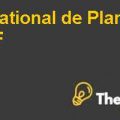
Diageo plc
Introduction
The report presents a case about Diageo plc, one of the world’s leading consumer goods company, which intends to sell its packed food subsidiary, Pillsbury, to General Mills and also intends to sell 20% of its Burger King subsidiary through an initial public offering. The objective of the company is to raise additional funds by divesting the shareholding and to exclusively focus on beverage alcohol industry.
Background
The Diageo plc was formed from the merger of world’s two leading consumer product companies, Grand Metropolitan plc and Guinness plc. The company has a diversified portfolio in spirits and wine, beer, packed food and restaurant industries. Diageo plc had enjoyed tremendous success over the past few years and is now considering to divest its shareholding in packed foods and restaurants, so that the company can focus on its most growing beverage spirit unit.
Problem Statement
The management of the company is concerned about the funds required to expand its operations in beverage spirits business. Further, the potential exit strategy can have a significant impact on the capital structure of the company, which requires the need for management to rethink its financing mix.
Case analysis
The report comprises of an analysis of the capital structure policies, which has been adopted by the company in the past and a comparison with the competitor’s policies. Further, it also contains an appraisal of the stimulation model and any adjustment required in the model. These are as follows:
- Capital structure policies adopted by Diageo and its comparison with competitors
- Significance of divesting Pillsbury and Burger King
- Evaluation of risk factors and any further adjustments required
Capital structure policies adopted by Diageo and its comparison with competitors
The Diageo plc adopted a conservative financial policy. Prior to the merger of Guinness and Grand Metropolitan, both the companies had relatively high credit rating on their bonds, which represents AA and A respectively. After the merger, the Diageo plc reported a credit rating of A+ as an average of both firms. The credit rating policy of the company depended on payment history, amount owed, length of credit history, new credit and types of credit used. The approach adopted by the treasury team of Diageo plc to measure its credit rating, depended on the interest coverage and EBITDA as a percentage of total debts. Although, it is a good measure but the management may consider to adopt other suitable measures as well.
First, the results of individual segment are determined and then the average of the segment’s results is compared with the group’s results. Exhibit 1 shows that the average interest coverage of the average of alcohol, beer, packed food and restaurant indicates 8.05, 10, 7.88 and 7.9 times respectively. The average interest coverage of Diageo plc represents 5 times, which is lower than the average of different segments which represent 8.46 times. Further, the average of EBITDA/ Total Debts of alcohol, beer, packed food and restaurant indicates 38%, 86%, 55% and 54% respectively. The result of Diageo plc represents 34% whereas the average of different segments represents 58.18%. Diageo plc has lower interest cover and EBITDA/Total debts as compared to its competitors, which may arise difficulty for Diageo plc in raising further funds as compared to its competitors.
Further evaluation in Exhibit 1 shows that the average book gearing of alcohol, beer, packed food and restaurant indicates 62%, 41%, 77% and 85% respectively. The result of Diageo plc represents 59% whereas the average of different segments represents 66.12% .Further, the market gearing of the average of alcohol, beer, packed food and restaurant indicates 28%, 17%, 19% and 21% respectively. The market gearing of Diageo plc represents 25% whereas the average of different segments represents 21.2%. The book gearing is low than industry average whereas; the results of market gearing is slightly higher than the average of segments.
Diageo plc intends to expand its operations in beverage alcohol segment, so it is more useful to compare it with the key competitor in alcohol industry i.e.: Allied Domecq. The interest coverage of Allied Domecq is 5.7 times which is higher than the interest coverage of Diageo plc which represents only 5 times. The book and market gearing of Allied Domecq represents 88% and 29% respectively whereas the book and market gearing of Diageo plc is low, which represents 59% and 25% respectively. Further, the credit rating of Diageo plc is A+ whereas the credit rating of Allied represents A-. However, the creditors will be more attracted towards Diageo plc because it has an impressive credit rating as compare to its competitor.
Significance of divesting Pillsbury and Burger King
An analysis has been performed to evaluate the contribution of individual units to the total amount. Exhibit 3 shows that the Pillsbury and King Burger contribute 32% and 8% respectively to the total revenue of the group whereas; their contribution to total profit margin represent 25% and 10% respectively. The packed goods division represents the second major division of the group in terms of revenue and profit margin and spirits and wine is the biggest division among all, which contributes 42% and 51% for turnover and profit margin respectively.
The group is considering to integrate the wine and beer division because the beer is the second largest division in terms of operating profit growth rate and it will also result in a cost saving of £130 per annum because the products and distribution channel of the two businesses are similar. The sale of Pillsbury and Burger King will raise funds, which will be used by the group to finance the organic growth in alcohol industry. The potential strategy will benefit the company to enjoy synergies because both the divisions will contribute their efforts to achieve the same common goal and it will also save cost of manufacturing, procurement and supply, which provides an incentive to the group to quote low price to customers.
Evaluation of risk factors and any further adjustments required
The present value of cash flows to the equity holders increases where the taxes paid and cost of financial distress is balanced, known as optimal point. The result of Monte Carlo Model in Figure 2 represents that 4.2 is the optimal point which maximizes the expected sum of financial distress costs and taxes paid. The strategy will significantly threaten the credit rating of the company because the results in Exhibit 5 show that the median interest coverage of 4.94 will have a BBB bond rating. It will raise issue for the group to raise funds because lower yield will threaten the confidence of the creditors, which might resist them to provide further funds to the group for expansion.
Different variables are considered in Monte Carlo Stimulation Model, which includes 15- year sequence which keeps track of operating cash flows, interest payments, interest coverage and distress on a semi-annual basis, EBIT, foreign exchange and market correlations but it fails to consider economic condition of the country, the nature.............................
This is just a sample partial case solution. Please place the order on the website to order your own originally done case solution.













